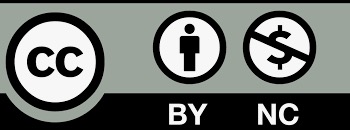Published
2023-12-29
Issue
Section
Research Articles
License
The journal adopts the Attribution-NonCommercial 4.0 International (CC BY-NC 4.0), which means that anyone can reuse and redistribute the materials for non-commercial purposes as long as you follow the license terms and the original source is properly cited.
Author(s) shall retain the copyright of their work and grant the Journal/Publisher rights for the first publication with the work concurrently licensed since 2023 Vol.8 No.2.
Under this license, author(s) will allow third parties to download, reuse, reprint, modify, distribute and/or copy the content under the condition that the authors are given credit. No permission is required from the authors or the publisher.
This broad license intends to facilitate free access, as well as the unrestricted use of original works of all types. This ensures that the published work is freely and openly available in perpetuity.
By providing open access, the following benefits are brought about:
- Higher Visibility, Availability and Citations-free and unlimited accessibility of the publication over the internet without any restrictions increases citation of the article.
- Ease of search-publications are easily searchable in search engines and indexing databases.
- Rapid Publication – accepted papers are immediately published online.
- Available for free download immediately after publication at https://esp.as-pub.com/index.php/ESP

Copyright Statement
1.The authors certify that the submitted manuscripts are original works, do not infringe the rights of others, are free from academic misconduct and confidentiality issues, and that there are no disputes over the authorship scheme of the collaborative articles. In case of infringement, academic misconduct and confidentiality issues, as well as disputes over the authorship scheme, all responsibilities will be borne by the authors.
2. The author agrees to grant the Editorial Office of Environment and Social Psychology a licence to use the reproduction right, distribution right, information network dissemination right, performance right, translation right, and compilation right of the submitted manuscript, including the work as a whole, as well as the diagrams, tables, abstracts, and any other parts that can be extracted from the work and used in accordance with the characteristics of the journal. The Editorial Board of Environment and Social Psychology has the right to use and sub-licence the above mentioned works for wide dissemination in print, electronic and online versions, and, in accordance with the characteristics of the periodical, for the period of legal protection of the property right of the copyright in the work, and for the territorial scope of the work throughout the world.
3. The authors are entitled to the copyright of their works under the relevant laws of Singapore, provided that they do not exercise their rights in a manner prejudicial to the interests of the Journal.
About Licence
Environment and Social Psychology is an open access journal and all published work is available under the Creative Commons Licence, Authors shall retain copyright of their work and grant the journal/publisher the right of first publication, and their work shall be licensed under the Attribution-NonCommercial 4.0 International (CC BY-NC 4.0).
Under this licence, the author grants permission to third parties to download, reuse, reprint, modify, distribute and/or copy the content with attribution to the author. No permission from the author or publisher is required.
This broad licence is intended to facilitate free access to and unrestricted use of original works of all kinds. This ensures that published works remain free and accessible in perpetuity. Submitted manuscripts, once accepted, are immediately available to the public and permanently accessible free of charge on the journal’s official website (https://esp.as-pub.com/index.php/ESP). Allowing users to read, download, copy, print, search for or link to the full text of the article, or use it for other legal purposes. However, the use of the work must retain the author's signature, be limited to non-commercial purposes, and not be interpretative.
Click to download <Agreement on the Licence for the Use of Copyright on Environmental and Social Psychology>.
How to Cite
Shaping e-waste recycling intentions through psychological motivation: An integrated study of the theory of planned behavior and the theory of Value-Belief-Norm
Yu Xiang
International College of National Institute of Development Administration, Khlong Chan, Bang Kapi District
Aweewan Mangmeechai
International College of National Institute of Development Administration, Khlong Chan, Bang Kapi District
DOI: https://doi.org/10.54517/esp.v9i3.2180
Keywords: electronic waste, theory of planned behavior, Value-Belief-Norm theory, psychological motivation
Abstract
This study analyzes the influencing factors of residents’ intention to participate in e-waste recycling behavior with the help of the theory of planned behavior (TPB) and Value-Belief-Norm (VBN) model. On the basis of factor analysis, through correlation analysis and regression analysis, this paper conducts an empirical study on the influencing factors of residents’ intention to participate in e-waste recycling behavior, revealing the formation mechanism of residents’ intention to participate in e-waste recycling behavior. The results show that Values, Awareness of consequences, Ascription of responsibility, Behavior attitude, Perceived behavior control and Personal norm are the main factors that affect residents’ participation in e-waste recycling behavior, and the impact of perceived behavior control is the most significant. The research results can help understand the formation mechanism and implementation process of residents’ e-waste recycling behavior intention, predict the possibility of residents’ participation in e-waste recycling behavior in the future, and provide some reference and inspiration for the research of residents’ participation in e-waste recycling behavior in China. In addition, we can essentially understand the reasons for the low recovery rate of e-waste and the lack of scale, and provide reference for the government and relevant departments to formulate corresponding policies and enterprises to establish a standardized recovery system.
References
[1]. Xu H. Where is the way out for China’s e-waste treatment? (Chinese). Ecological Economy, 34(7), 4.
[2]. Forti V, Balde CP, Kuehr R, Bel G. The Global E-waste Monitor 2020: Quantities, flows and the circular economy potential. 2020.
[3]. Darby L, Obara L. Household recycling behaviour and attitudes towards the disposal of small electrical and electronic equipment. Resources, Conservation and Recycling. 2005, 44(1): 17-35. doi: 10.1016/j.resconrec.2004.09.002
[4]. Zeng X, Gong R, Chen WQ, et al. Uncovering the Recycling Potential of “New” WEEE in China. Environmental Science & Technology. 2016, 50(3): 1347-1358. doi: 10.1021/acs.est.5b05446
[5]. Zhang W, Jiang H, Wang J, Lu Y. Amount of electronic waste generated in China: Prediction and characteristics analysis (Chinese). Environmental Science & Technology. 2013, 36(6): 5.
[6]. Ge YJ, Jin YY, Nie YF. Recovery and management of electronic wastes: Status quo and needs for improvement. Environmental Science & Technology. 2006, 29(3): 3.
[7]. Shittu OS, Williams ID, Shaw PJ. Global E-waste management: Can WEEE make a difference? A review of e-waste trends, legislation, contemporary issues and future challenges. Waste Management. 2021, 120: 549-563. doi: 10.1016/j.wasman.2020.10.016
[8]. Sakhuja D, Ghai H, Bhatia RK, et al. Management of E-Waste: Technological Challenges and Opportunities. Handbook of Solid Waste Management. 2022, 1523-1557. doi: 10.1007/978-981-16-4230-2_69
[9]. Murthy V, Ramakrishna S. A Review on Global E-Waste Management: Urban Mining towards a Sustainable Future and Circular Economy. Sustainability. 2022, 14(2): 647. doi: 10.3390/su14020647
[10]. Li W, Achal V. Environmental and health impacts due to e-waste disposal in China—A review. Science of The Total Environment. 2020, 737: 139745. doi: 10.1016/j.scitotenv.2020.139745
[11]. Cucchiella F, D’Adamo I, Lenny Koh SC, et al. Recycling of WEEEs: An economic assessment of present and future e-waste streams. Renewable and Sustainable Energy Reviews. 2015, 51: 263-272. doi: 10.1016/j.rser.2015.06.010
[12]. Bosnjak M, Ajzen I, Schmidt P. The theory of planned behavior: Selected recent advances and applications. Europe’s Journal of Psychology. 2020, 16(3): 352-356. doi: 10.5964/ejop.v16i3.3107
[13]. Ajzen I, Fishbein M. A Bayesian analysis of attribution processes. Psychological Bulletin. 1975, 82(2): 261-277. doi: 10.1037/h0076477
[14]. Ajzen I. From Intentions to Actions: A Theory of Planned Behavior. Action Control. 1985, 11-39. doi: 10.1007/978-3-642-69746-3_2
[15]. Ajzen I. The theory of planned behavior. Organizational Behavior and Human Decision Processes. 1991, 50(2): 179-211. doi: 10.1016/0749-5978(91)90020-t
[16]. Wiidegren Ö. The New Environmental Paradigm and Personal Norms. Environment and Behavior. 1998, 30(1): 75-100. doi: 10.1177/0013916598301004
[17]. Wan C, Shen GQ, Choi S. Experiential and instrumental attitudes: Interaction effect of attitude and subjective norm on recycling intention. Journal of Environmental Psychology. 2017, 50: 69-79. doi: 10.1016/j.jenvp.2017.02.006
[18]. Tonglet M, Phillips PS, Bates MP. Determining the drivers for householder pro-environmental behaviour: waste minimisation compared to recycling. Resources, Conservation and Recycling. 2004, 42(1): 27-48. doi: 10.1016/j.resconrec.2004.02.001
[19]. Zhong H, Huang L. The Empirical Research on the Consumers’ Willingness to Participate in E-waste Recycling with a Points Reward System. Energy Procedia. 2016, 104: 475-480. doi: 10.1016/j.egypro.2016.12.080
[20]. Wang Z, Guo D, Wang X. Determinants of residents’ e-waste recycling behaviour intentions: Evidence from China. Journal of Cleaner Production. 2016, 137: 850-860. doi: 10.1016/j.jclepro.2016.07.155
[21]. Stone TH, Jawahar IM, Kisamore JL. Using the theory of planned behavior and cheating justifications to predict academic misconduct. Career Development International. 2009, 14(3): 221-241. doi: 10.1108/13620430910966415
[22]. Jia D. Analysis of public willingness to participate in environmental public decision-making based on planned behavior theory (Chinese). Contemporary Economic Management. 2018, 40(1): 7.
[23]. Conner M, Armitage CJ. Extending the Theory of Planned Behavior: A Review and Avenues for Further Research. Journal of Applied Social Psychology. 1998, 28(15): 1429-1464. doi: 10.1111/j.1559-1816.1998.tb01685.x
[24]. Stern PC. New Environmental Theories: Toward a Coherent Theory of Environmentally Significant Behavior. Journal of Social Issues. 2000, 56(3): 407-424. doi: 10.1111/0022-4537.00175
[25]. Schwartz SH. Normative Influences on Altruism. Advances in Experimental Social Psychology. 1977, 221-279. doi: 10.1016/s0065-2601(08)60358-5
[26]. Stern PC, Dietz T, Abel T, et al. A value-belief-norm theory of support for social movements: The case of environmentalism. Human Ecology Review. 1999, 6(2): 81-97.
[27]. Yue T. Research on Influencing Factors and Guiding Policy of Energy-Conservation Behavior of Urban Residents (Chinese). China University of Mining and Technology; 2014.
[28]. Chen MF, Tung PJ. Developing an extended Theory of Planned Behavior model to predict consumers’ intention to visit green hotels. International Journal of Hospitality Management. 2014, 36: 221-230. doi: 10.1016/j.ijhm.2013.09.006
[29]. Han H. Travelers’ pro-environmental behavior in a green lodging context: Converging value-belief-norm theory and the theory of planned behavior. Tourism Management. 2015, 47: 164-177. doi: 10.1016/j.tourman.2014.09.014
[30]. Pomazal RJ, Jaccard JJ. An informational approach to altruistic behavior. Journal of Personality and Social Psychology. 1976, 33(3): 317-326. doi: 10.1037/0022-3514.33.3.317
[31]. van Riper CJ, Kyle GT. Understanding the internal processes of behavioral engagement in a national park: A latent variable path analysis of the value-belief-norm theory. Journal of Environmental Psychology. 2014, 38: 288-297. doi: 10.1016/j.jenvp.2014.03.002
[32]. Han H. Travelers’ pro-environmental behavior in a green lodging context: Converging value-belief-norm theory and the theory of planned behavior. Tourism Management. 2015, 47: 164-177. doi: 10.1016/j.tourman.2014.09.014
[33]. Klöckner CA, Blöbaum A. A comprehensive action determination model: Toward a broader understanding of ecological behaviour using the example of travel mode choice. Journal of Environmental Psychology. 2010, 30(4): 574-586. doi: 10.1016/j.jenvp.2010.03.001
[34]. Hu B, Fu Y, Xiong Y. The driving factors and the formation mechanism of tourists’ intention participating in low-carbon tourism: Based on theory of planned behavior (Chinese). Business Economics Administration. 2014, 8(9): 64-72. doi: 10.3969/j.issn.1000-2154.2014.08.007
[35]. Oreg S, Katz-Gerro T. Predicting Proenvironmental Behavior Cross-Nationally. Environment and Behavior. 2006, 38(4): 462-483. doi: 10.1177/0013916505286012
[36]. Cao H, Zhao K. Influence factors and effect decomposition of households’ intention of chemical fertilizer reduction: An empirical analysis based on VBN-TPB (Chinese). Journal of Huazhong Agricultural University: Social Sciences Edition. 2018, 6: 29-38.
[37]. De Groot J, Steg L. General Beliefs and the Theory of Planned Behavior: The Role of Environmental Concerns in the TPB. Journal of Applied Social Psychology. 2007, 37(8): 1817-1836. doi: 10.1111/j.1559-1816.2007.00239.x
[38]. Petschnig M, Heidenreich S, Spieth P. Innovative alternatives take action – Investigating determinants of alternative fuel vehicle adoption. Transportation Research Part A: Policy and Practice. 2014, 61: 68-83. doi: 10.1016/j.tra.2014.01.001
[39]. Wang Y, Ma J, Ma B. Research on recycling status and recycling mode of waste mobile phones in China (Chinese). Economist. 2013, (6): 51-53.
[40]. Arı E, Yılmaz V. A proposed structural model for housewives’ recycling behavior: A case study from Turkey. Ecological Economics. 2016, 129: 132-142. doi: 10.1016/j.ecolecon.2016.06.002
[41]. Oztekin C, Teksöz G, Pamuk S, et al. Gender perspective on the factors predicting recycling behavior: Implications from the theory of planned behavior. Waste Management. 2017, 62: 290-302. doi: 10.1016/j.wasman.2016.12.036
[42]. Zhang S, Zhang M, Yu X, et al. What keeps Chinese from recycling: Accessibility of recycling facilities and the behavior. Resources, Conservation and Recycling. 2016, 109: 176-186. doi: 10.1016/j.resconrec.2016.02.008
[43]. Tong X, Nikolic I, Dijkhuizen B, et al. Behaviour change in post-consumer recycling: Applying agent-based modelling in social experiment. Journal of Cleaner Production. 2018, 187: 1006-1013. doi: 10.1016/j.jclepro.2018.03.261
[44]. Sheppard BH, Hartwick J, Warshaw PR. The Theory of Reasoned Action: A Meta-Analysis of Past Research with Recommendations for Modifications and Future Research. Journal of Consumer Research. 1988, 15(3): 325. doi: 10.1086/209170
[45]. Schwartz SH. Universals in the Content and Structure of Values: Theoretical Advances and Empirical Tests in 20 Countries. Advances in Experimental Social Psychology. 1992, 1-65. doi: 10.1016/s0065-2601(08)60281-6
[46]. Huang X, Lu Z, Wang YA. Study on Construction Analysis Model of Influencing Factors of Low-carbon Touristic Living Behaviors Based on TPB and VBN. Science and Technology Management Research. 2013, 33(21): 10.
[47]. Bamberg S, Möser G. Twenty years after Hines, Hungerford, and Tomera: A new meta-analysis of psycho-social determinants of pro-environmental behaviour. Journal of Environmental Psychology. 2007, 27(1): 14-25. doi: 10.1016/j.jenvp.2006.12.002
[48]. Sutton S. The past predicts the future: Interpreting behaviour—behaviour relationships in social psychological models of health behaviour. In: Rutter DR, Quine L (editors). Social Psychology and Health: European Perspectives. Avebury/Ashgate Publishing Co.; 1994. pp. 71–88.
[49]. Matthies E, Selge S, Klöckner CA. The role of parental behaviour for the development of behaviour specific environmental norms – The example of recycling and re-use behaviour. Journal of Environmental Psychology. 2012, 32(3): 277-284. doi: 10.1016/j.jenvp.2012.04.003
[50]. Kline RB. Principles and Practice of Structural Equation Modeling. Guilford Press; 2011.
[51]. Hair JF. Multivariate Data Analysis, 5th ed. Prentice Hall; 1998.
[52]. Fornell C, Larcker DF. Evaluating Structural Equation Models with Unobservable Variables and Measurement Error. Journal of Marketing Research. 1981, 18(1): 39-50. doi: 10.1177/002224378101800104
[53]. Chin WW. Issues and opinion on structural equation modeling. Management Information Systems Research Center, University of Minnesota. 1998, 22(1).
[54]. Sheeran P, Orbell S. Augmenting the Theory of Planned Behavior: Roles for Anticipated Regret and Descriptive Norms1. Journal of Applied Social Psychology. 1999, 29(10): 2107-2142. doi: 10.1111/j.1559-1816.1999.tb02298.x
[55]. Kiatkawsin K, Han H. Young travelers’ intention to behave pro-environmentally: Merging the value-belief-norm theory and the expectancy theory. Tourism Management. 2017, 59: 76-88. doi: 10.1016/j.tourman.2016.06.018
[56]. Yu J, Williams E, Ju M, et al. Managing e-waste in China: Policies, pilot projects and alternative approaches. Resources, Conservation and Recycling. 2010, 54(11): 991-999. doi: 10.1016/j.resconrec.2010.02.006







